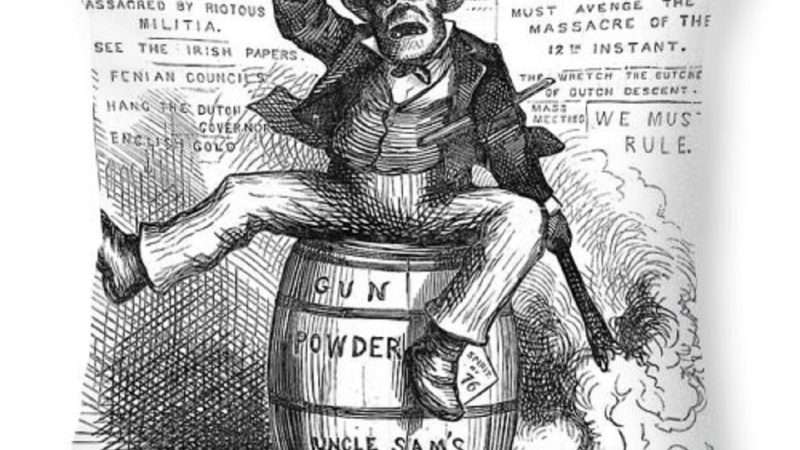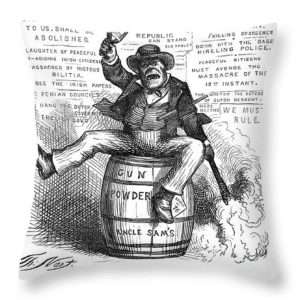

Hispanics are by far the largest American immigration group of the last several decades, and also the focus of the most extensive nativist concerns. Immigration restrictionists contend that Hispanic immigrants increase crime, undermine American political institutions, and cannot or will not assimilate. In a recent post, prominent economic policy commentator Noah Smith compiles evidence that these complaints are largely misplaced, and that Hispanics are in fact following a trajectory similar to that of Irish-Americans in the late-nineteenth and early-twentieth centuries:
[T]he best historical analogy for Hispanic immigration to the U.S. is the great Irish immigration of the 1800s. The usual analogy we draw is to the Italians, but I think the Irish make a better model. First of all, Irish immigration, like immigration from Mexico and Central America — but unlike immigration from Italy — was very drawn-out over a long period of time….
Like Hispanics, Irish migrants were mostly working-class folks who came for mainly economic reasons — pressures from poverty back in Ireland, plus the great dream of making it in America. And like Hispanics, they provoked a sustained and ferocious pushback from nativists….
The cartoon at the top of this post is from 1871 [note: I have reproduced the same cartoon at the start of this post], and features a huge number of negative stereotypes — the Irish as terrorists, as drunkards, as criminals, as seeking to dominate American culture….
You can see these anxieties paralleled in modern conservative worries about Hispanic immigration. Conservatives worry that terrorists are coming up through the southern border, that traditional American culture will be destroyed by immigrant culture, or even that the U.S. will have a civil war along racial lines.
Economic concerns are also very similar…. Worries that poor Irish immigrants would swamp local welfare systems — similar to worries about Hispanics overloading the welfare state in the 1990s and beyond — resulted in a large number of restrictive anti-immigration measures at the state level…..
Today's fears of supposedly violent and unassimilable Hispanics are remarkably similar to the nineteenth century stereotype of brutish, un-American Irishmen.
In the rest of the article, Smith compiles evidence that the concerns about Hispanics are largely false: they are in fact rapidly assimilating, quickly increasing their wealth and income, and have significantly lower crime rates than native-born Americans (a point that applies even to undocumented immigrants). Most of this evidence is well-known to students of immigration policy. But Smith does a valuable service in compiling it in one relatively short and easily accessible piece.
I have previously written about how once widespread hostility towards Irish-Americans gradually faded away to the point where the difference between Irish and other white Americans no longer has much political or social significance. For example, most Americans barely even notice that Joe Biden is only the second Irish Catholic president, and hardly anyone worries that he's trying to advance Irish interests at the expense of WASPs, or that he's following the dictates of the Vatican. As Smith explains, the distinction between whites and Hispanics may well be gradually moving in the same direction.
I would, however, note a few relevant caveats to Smith's thesis. First, it is not entirely true that Irish and Hispanic immigrants "were mostly working-class folks who came for mainly economic reasons." In reality, many Hispanic immigrants were and are refugees from oppressive socialist regimes in Cuba, Nicaragua, and (most recently) Venezuela. Some others have fled repression at the hands of right-wing dictatorships. For their part, the many Irish migrants were fleeing not just poverty, but also repression at the hands of the British. This experience with repression in their countries of origin likely strengthens the migrants' attachment to American institution, which, despite various flaws, offer them greater freedom and tolerance than those they fled.
A second caveat is that Hispanic migrants are a much more diverse lot than the Irish were. They come from a variety of different nations and ethnic groups. This makes generalizations about them more difficult. Cubans, Mexicans, Salvadorans, Brazilians, and others all have somewhat different backgrounds and experiences, though there are some commonalities, as well. Indeed, as my George Mason University colleague David Bernstein shows in a recent book, "Hispanic" is actually a largely artificial category created not by the migrants themselves, but by US government bureaucrats.
Finally, while Irish immigrants arrived in an era when there were few restrictions on European immigration, many Hispanic migrants are undocumented. Today, there are an estimated 7 million or more undocumented Hispanic immigrants in the US, which accounts for some one-third of all foreign-born Hispanics, and over 70% of the total undocumented immigrant population.
For obvious reasons, lack of legal status reduces migrants' incomes and educational opportunities, and impedes assimilation. The existence of this anchor makes Hispanics' progress look even more impressive than it would be otherwise. But, unless immigration policy changes, it is likely to continue to slow down the assimilation process highlighted by Smith.
The obvious solution to this problem is simply to grant legal status to the undocumented, or at least the vast majority of them. Previous amnesties have increased income and assimilation, and a new one would likely have similar effects (thereby also boosting the US economy in the process). But that may not be politically feasible for some time to come.
UPDATE: In my post, I list Brazilians as one of the "Hispanic" groups. But the federal government does not classify them as such, because the official definition of Hispanic is limited to people of "Spanish culture or origin." However, many Brazilians do describe themselves as "Hispanic" or "Latino" in surveys, and they are often colloquially described as "Hispanic" by others. Ultimately, little in my analysis turns on whether Brazilians are properly considered "Hispanic" or not. Even if we exclude them, the Hispanic category is still remarkably diverse, including people with origins in a variety of different countries.
The post Are Hispanics Following the Path of the Irish? appeared first on Reason.com.







